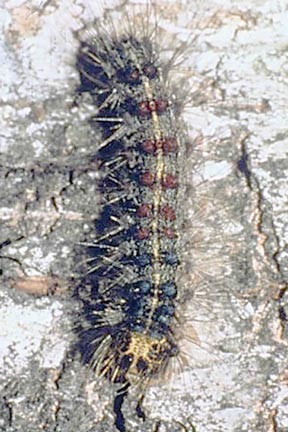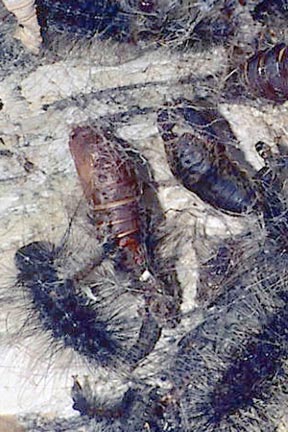Gypsy Moth | |
|---|---|
| June 26, 2007 | |
|
Gypsy moth larvae are causing damage in new areas in northeastern Illinois. After becoming widespread in Lake County, the most northeastern county in the state, several years ago, they have been moving relatively slowly through adjoining counties. However, this year they appear to be spreading more rapidly again with higher populations. There have been heavy infestations in Naperville, Glen Ellyn, and other areas of Cook, DuPage, and McHenry Counties. These infestations were not treated until the caterpillars were large, resulting in relatively poor control.  Gypsy moth mature larva on maple. Gypsy moth caterpillars are hairy, dark-colored, with a double row of blue and red balls down the back. Fully grown caterpillars are 1-1/2 to 2 inches long. They prefer to feed on the foliage at the top of trees, but more feed lower in the canopy as larval populations rise or as preferred leaves are eaten. Oaks are preferred, but many other tree species are also attacked. At this time of year, caterpillars soon form brown pupae about 1 inch long, embedded into silk. Adult moths emerge in a few weeks. Male moths have brown wings with black V-shaped markings and a 1-1/2- inch wingspan. They are excellent fliers, commonly in flight during the day around trees containing female moths. Female moths have white wings with black V-shaped markings and a 2-inch wingspan. Those in Illinois and throughout the Midwest are unable to fly. After mating, female moths lay an egg mass that is about 1 inch long by 3/8 to 1/2 inch wide. The egg masses contain up to 1,000 eggs and are covered with the buff-colored hairs of the female’s abdomen. Egg masses are typically laid under loose bark or on top of the bark of attacked trees. However, egg masses can be laid almost anywhere. The eggs overwinter and hatch the following spring at oak leaf emergence.  Gypsy moth pupae on birch. In general, controlling caterpillars with insecticides becomes more difficult as the caterpillars grow older. Gypsy moth is no exception. Treatment at this time with insecticides is likely to provide very poor control. Several inch-wide burlap bands around the trunk of infested trees will attract many pupating larvae so that they can be removed and destroyed. Otherwise, make notes of locations of infested trees to scout them and provide effective control next year. Egg masses can also be removed and destroyed from now until next spring. (Phil Nixon, Susan Grupp, James Schuster, Morton Arboretum) | |
| Author: | Phil Nixon |
